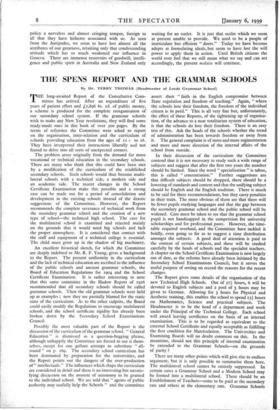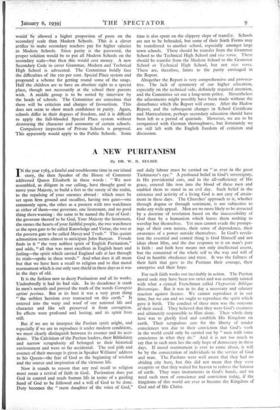THE SPENS REPORT AND THE GRAMMAR SCHOOLS
By Dr. TERRY THOMAS (Headmaster of Leeds Grammar School)
THE long-awaited Report of the Consultative Com- mittee has arrived. After an expenditure of five years of patient effort and £2,896 6s. 2d. of public money, a scheme is produced for the complete reorganisation of our secondary school system. If the grammar schools wish to make any New Year resolutions, they will find some ready-made ones in this book of over 500 pages. By the terms of reference the Committee were asked to report on the organisation, inter-relation and the curriculum of schools providing education from the ages of x x + to i6. They have interpreted their instructions liberally and not feared to delve into all sorts of unexpected corners.
The problem arose originally from the demand for more vocational or technical education in the secondary schools. There are many who think that this could have been met by a modification of the curriculum of the established secondary schools. Such schools would thus become multi- lateral schools with a technical side, a modern side and an academic side. The recent changes in the School Certificate Examination make this possible and a strong case can be made out for a period of consolidation and development in the existing schools instead of the drastic suggestions of the Committee. However, the Report recommends the complete severance of technical work from the secondary grammar school and the creation of a new type of school—the technical high school. The case for the multilateral school is examined and rejected mainly on the grounds that it would need big schools and lack the proper atmosphere. It is considered that contact with the staff and equipment of a technical college is essential. The child must grow up in the shadow of big machinery.
An excellent historical sketch, for which the Committee are deeply indebted to Mr. R. F. Young, gives a background to the Report. The present uniformity in the curriculum and the lack of technical education are ascribed to the influence of the public schools and ancient grammar schools, the Board of Education Regulations for 1904 and the School Certificate Examination. It is rather interesting to note that this same committee in the Hadow Report of 1926 recommended that all secondary schools should be called grammar schools. Then the old grammar schools were held up as examples ; now they are partially blamed for the static state of the curriculum. As to the other culprits, the Board could easily modify the Regulations to encourage multilateral schools, and the school certificate rigidity has already been broken down by the Secondary School Examinations Council.
Possibly the most valuable part of the Report is the discussion of the curriculum of the grammar school. " General Education " is dismissed as a question-begging phrase, although unhappily the Committee are forced to use it them- selves, except for one gallant attempt to substitute " all- round " on p. 169. The secondary school curriculum has been dominated by preparation for the universities, and the Report points out the dangers of the over-production of " intellectuals." The influences which shape the curriculum are considered in detail and there is an interesting but unsatis- fying discussion on the amount of autonomy to be granted to the individual school. We are told that " agents of public authority may usefully help the Schools " and the committee assert their " faith in the English compromise between State regulation and freedom of teaching." Again, " where the schools lose their freedom, the freedom of the individual citizen is in peril." This is all very fine but, unfortunately, the effect of these Reports, of the tightening up of organisa- tion, of the advance to a neat totalitarian system of education, is that the schools do lose their freedom. There is an easy test of this. Ask the heads of the schools whether the trend of administration has been towards freedom or away from it. The general complaint is of more and more regimentation and more and more direction of the internal affairs of the school from outside.
In their discussion of the curriculum the Committee contend that it is not necessary to study such a wide range of subjects and suggest that after the first two years the number should be limited. Since the word " specialisation " is taboo, this is called " concentration." Further suggestions are that difficult subjects should be dropped, there should be a lowering of standards and content and that the unifying subject should be English and the English tradition. There is much to be said for these recommendations, but they carry penalties in their train. The more obvious of them are that there will be fewer pupils studying languages and that the gap between the secondary grammar school and the public school will be widened. Care must be taken to see that the grammar school pupil is not handicapped in the competition for university scholarships and for professional posts. However, the time- table required overhaul, and the Committee have tackled it boldly, even going so far as to suggest a time distribution amongst the subjects. A good deal of attention is paid to the content of certain subjects, and these will be studied carefully by the heads of schools and the specialist teachers. A chapter on the School Certificate Examination is now largely out of date, as the reforms have already been initiated by the Secondary School Examinations Council, but it serves the useful purpose of setting on record the reasons for the recent changes.
The Report gives some details of the organisation of the new Technical High Schools. Out of 27i hours, 6 will be devoted to English subjects and a pool of 3 hours may be given to German. Allowing for 3 hours for Physical and Aesthetic training, this enables the school to spend I51, hours on Mathematics, Science and practical subjects. The Headmaster is to be the head of a department and work under the Principal of the Technical College. Each school will award leaving certificates on the basis of an internal examination. This is to be regarded as equivalent to the external School Certificate and equally acceptable as fulfilling the first condition for Matriculation. The Universities and Examining Boards will no doubt comment on this. In the meantime, should not this principle of internal examination be extended to the Grammar Schools—on the grounds of parity ?
There are many other points which will give rise to endless argument, but it is only possible to summarise them here. The multilateral school cannot be entirely suppressed. In certain cases a Grammar School and a Modern School may be formed into a multilateral school. There should be an Establishment of Teachers—some to be paid at the secondary rate and others at the elementary rate. Grammar Schools would be allowed a higher proportion of posts on the seconda0 scale than Modern Schools. This is a clever artifice -'to make secondary teachers pay for higher salaries in Modern Schools. Since parity is the password, the proper -solUtMn would be to put all Modern Schools on the secondary scale—but then this would cost money. A new Secondary Code to cover Grammar, Modern and Technical High School is advocated. The Committee boldly face the difficulties of the too per cent. Special Place system and propound a scheme for getting round some of the snags. Half the children are to have an absolute right to a special place, though not necessarily at the school their parents wish. A middle group is to be sorted by interview by the heads of schools. The Committee are conscious that there will be criticism and charges of favouritism. This does not seem to show much confidence in parity. Again, schools differ in their degrees of freedom, and it is difficult to apply the full-blooded Special Place system without destroying the character and autonomy of certain schools.
Compulsory inspection of Private Schools is proposed. This apparently would apply to the Public Schools. Some time is also spent on the slippery slope of transfer. Schools are not to be beheaded, but some of their Sixth Forms may be transferred to another school, especially amongst large town schools. There should be transfer from the Grammar School to the Technical High School and vice versa. There should be transfer from the Modern School to the Grammar School or Technical High School, but not vice versa. There are, therefore, limits to the parity envisaged in the Report.
Altogether the Report is very comprehensive and provoca- tive. The lack of symmetry of our higher education, especially on the technical side, definitely required attention, and the Committee set out a long-term policy. Nevertheless the adjustments might possibly have been made without the disturbance which the Report will create. After the Hadow Report, and the subsequent changes in School Certificate and Matriculation, perhaps secondary education should have been left to a period of quietude. However, we are to be reorganised with German thoroughness, but fortunately we are still left with the English freedom of criticism and discussion.











































 Previous page
Previous page